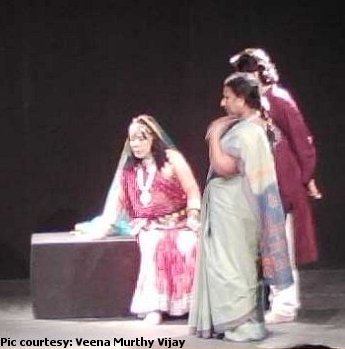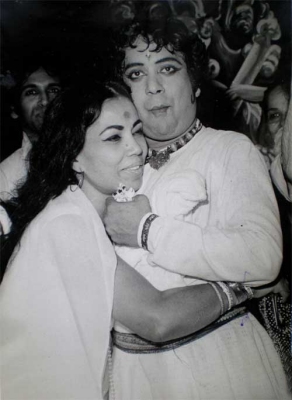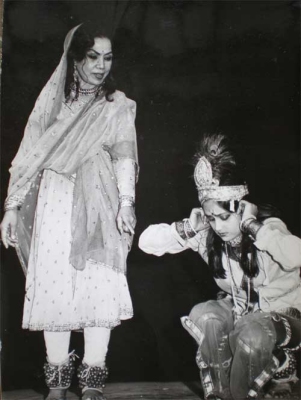
|   |

|   |
With Sitara Devi at Sangeet Natak Akademi award dinner - Dr. Sunil Kothari e-mail: sunilkothari1933@gmail.com July 27, 2009 Ah, it is always a pleasure to meet the awardees during the Sangeet Natak Akademi's award function. This year it was held at Vigyan Bhavan, and it brought back many memories. The artistes and invitees began to fill the hall. Because of security regulations, we had to leave our mobile phones outside in deposit. The spacious hall looked very impressive. The awardees were seated on the right hand side, facing the stage; the Fellows were Sitara Devi, Prof RC Mehta, Dr. Bhupen Hazarika. Sitara looked her imperious and glamorous self, with make up, ornaments, a sari with all the zig zig, bangles and a happy smile.  Sitara Devi, Helen Acharya (Deputy Director, Dance, Sangeet Natak Akademi) Shri Ram Nivas Mirdha, the Chairman of Sangeet Natak Akademi, had arranged a dinner in honour of elected Fellows and Awardees of the Akademi, at Meghadoot complex in the recently built air-conditioned hall. Therefore in this month of July with high humidity, it was such a relief. The invitees streamed in, in their fineries, greeting the awardees and friends. Only soft drinks were served. Sitara spotted me and sent her daughter to summon me. She had put on another sari with all the 'zag mag-chamak damak' shining material. She looked in her element. In walked Vasant Sathe, looking debonair, at 80 plus. He greeted Sitara and sat next to her. Many asked me how old she was since I have known her for long. They think she is 80 plus. But her love for life and zest has not diminished with advancing age. It was stuffy in the extension where dinner was to be served. So some of us filled our plates and settled in the a/c hall. Sitara asked me to sit next to her while her daughter Jayantimala went to get her food. Shanta Serbjeet Singh, Arundhati Shankar Nag and others joined us. Sitara was in a happy mood. So when Shanta asked her politely, "Do you wish for anything more?" she smiled and said, "Would love to continue dancing. Have composed some new bandishes. Had been to Udaipur," and reminisced for a while. Then she turned around and said, "Sunil, you have written a book on Kathak, but you have put so many photos of Birju Maharaj's disciples - and only one of mine!" I loved the way she said it and knew she would now take all to task, not with any particular feeling of anger, but to vent her dissatisfaction at the Kathak scene and how it is growing.   Sitara gets angry when someone speaks of Benaras gharana. Or Janaki Prasad gharana. With complete innocence she asks, "Tell me when you think of the first ancient city of India, what would you think of?" I said, "Of course Benaras!" She smiled. "That is the city where we were brought up!" I was born and brought up in Mumbai. During my school days I had studied Kathak at Deodhar's classes near Opera House. When I saw Sitara for the first time at Rang Bhavan when I was in First Year Arts at Wilson College, I was mesmerized. I had never seen anything like that. She was enacting abhinaya to Bindadin Maharaj's thumri. On listening to Krishna's flute, the gopis left their daily chores and their homes to see Krishna. She impersonated several gopis, how they walked, how they rushed, how they forgot to put on correct ornaments and how each one was different. Though it was only one dancer on the stage, she created an illusion of several gopis. So powerful was her abhinaya and when she executed tode, tukde, parans, she electrified the stage! I became her ardent devotee and admirer. In Mumbai, Brijnarain-ji used to organize Haridas Sammelan and Kal ke Kalakar festivals under the aegis of Sur Singar Samsad. When I started lecture-demonstrations and was in charge of Kal ke Kalakar, Sitara always supported me. She would also dance and bring down the house. Her joi de vivre was infectious. From 1970 till 1980, I arranged those lec-dems and performances at the CJ Hall. (We used to call it our Royal Albert Hall). Our friendship over the years has grown. Sitara liked the food. And suddenly remembered and said, "Shanta, once Sunil brought some 40 Russian dancers to my flat and said, 'Didi, they want to see dance.' I said OK. Some sat in front on the floor, some stood and I danced. They whistled and cheered… what wonderful days…" Our puppeteer friend Dadi Padamjee chirped in, "Sunil once wrote about a dancer as 'sada bahar'- evergreen…" and trailed off. In 1980, at AIFACS Hall, in Delhi, during Kathak Festival, Sitara was dancing. I had done a curtain raiser in my column in The Economic Times. I had mentioned the participants paying tributes 'to ever young' Sitara, Rohini Bhate for her pioneering work in Maharashtra and Kumudini Lakhia in Gujarat. Latif Ahmed was accompanying her on tabla. At the end of the program, I do not know what happened. She in her usual manner admonished young dancers and said loudly, "Where is Sunil Kothari? He writes I am 'evergreen.' Where is Rohini Bhate? I have been dancing in Maharashtra from the time I settled in Mumbai - and he says she is a pioneer?" and so on. Of course, I was unfazed, having known her for so many years. I told Dadi Padamjee that in the next Sunday in Business Standard, Kavita Nagpal had referred to Sitara's outburst against me. Remembering that, Sitara smiled and said, "I must have admonished him! Critics must study the dance form properly." I recalled one evening at her flat in Mumbai when I had gone with Nayana Jhaveri (the eldest of the Jhaveri Sisters), and she was expecting guests. She told Nayanaben that she should take me with her, because the party was in honour of Sheikh Abdullah from Kashmir and there would be singing and dancing. I wanted 'to hang on' to see how Sitara would entertain such a dignitary. Sheikh Abdullah was a great fan of Sitara. We reminisced a bit more. She has a terrific sense of humour. She likes to talk and enjoys the reverence and attention others pay her. Arundhati speaks Gujarati well, so when she spoke in Gujarati, I told Sitara, "Arundhati was in Mumbai and acting in plays for INT (Indian National Theatre). She was a great friend of Protima." Sitara smiled and said, "Protima was a good hearted woman." Arundhati agreed. Both Sitara and Protima had something common in their temperament! So many memories. The photographers were clicking away merrily. Group photos were taken. Sitara was brought to the room in a wheelchair but the smile was there as if she was walking in style. Sitara was the centre of attraction. People adore her. Such dancers we come across as they say, once in a century. It was time to leave and I touched her feet. She blessed me in her usual style: "Jiyo!" (Long live!) Responses  Dr. Sunil Kothari, dance historian, scholar, author, is a renowned dance critic, having written for The Times of India group of publications for more than 40 years. He is a regular contributor to Dance Magazine, New York. Dr. Kothari is a globetrotter, attending several national, international dance conferences and dance festivals. He has to his credit more than 14 definitive works on Indian classical dance forms. Kothari was a Fulbright Professor and has taught at the Dance Department, New York University; has lectured at several Universities in USA, UK, France, Australia, Indonesia and Japan. He has been Vice President of World Dance Alliance Asia Pacific (2000-2008) and is Vice President of World Dance Alliance Asia Pacific India chapter, based in New Delhi. A regular contributor to narthaki.com, Dr Kothari is honored by the President of India with the civil honor of Padma Shri and Sangeet Natak Akademi award. He recently received the Senior Critic award from Dance Critics Association, NYC. |